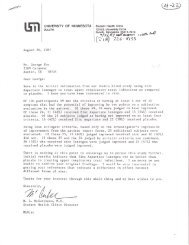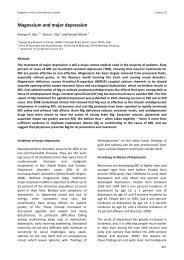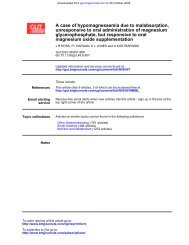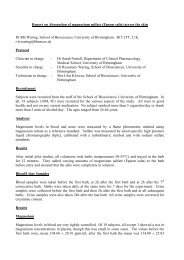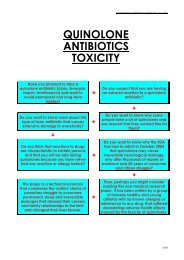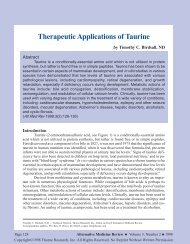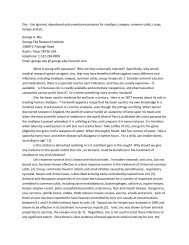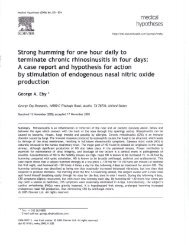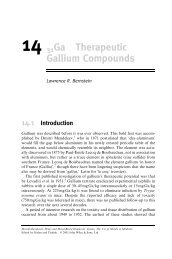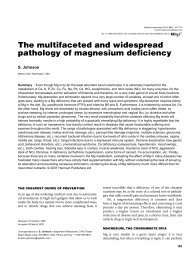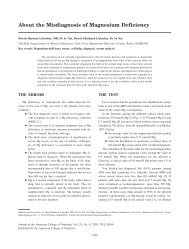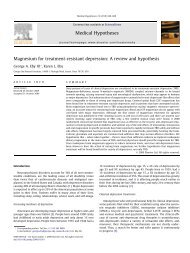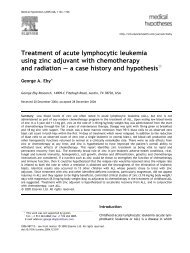2003 article - George Eby Research Institute
2003 article - George Eby Research Institute
2003 article - George Eby Research Institute
You also want an ePaper? Increase the reach of your titles
YUMPU automatically turns print PDFs into web optimized ePapers that Google loves.
F. Iraji, G. Faghihi<br />
caused some irritation. 7<br />
Humoral and cell-mediated immunity do not<br />
fully protect against recurrent herpes simplex, but<br />
where immunity is deficient, recurrent herpetic<br />
infection may be more frequent and more severe.<br />
8, 9 In our study, 31.3% of patients had some<br />
degree of immunodeficiency. These patients<br />
responded less to treatment than immunocompetent<br />
individuals. Mild uncomplicated<br />
eruptions of herpes simplex require no treatment,<br />
but frequent recurrences and any associated<br />
erythema multiform should be suppressed by safe<br />
10, 11<br />
and cost-effective long-term treatment.<br />
Zinc can also regulate human DNA and RNA<br />
polymerases and thymidine kinase, so plays an<br />
important role in normal immunological<br />
12 – 14<br />
functions.<br />
Zinc ions have been reported to be antiviral to<br />
HSV. Long-term topical application of zinc salts<br />
appears to greatly reduce or eliminate recurrence<br />
of genital herpetic infections. 15 Zinc ions can<br />
precipitate protein, and Sharquie et al clearly<br />
showed that zinc sulfate causes very high<br />
inhibition of growth of amastigotes of Leishmania<br />
spp. 16 Thus, zinc sulfate has been used to treat<br />
oriental sores. Zinc monoglycerolate is also<br />
effective against oral herpetic sores. 17<br />
Further studies must be carried out to<br />
determine the mechanisms of the response of<br />
HSV infection to zinc ions, which could be<br />
through enhancement of the host’s cellular<br />
immunity.<br />
Acknowledgments<br />
We wish to thank Dr. M.R. Radan MD, for<br />
his assistance in drafting the manuscript. Our<br />
regards also go to the <strong>Research</strong> Council of<br />
Isfahan University of Medical Sciences and the<br />
Head of the Dermatology Department and the<br />
Manager of International and Foreign Affairs of<br />
Isfahan University of Medical Sciences, School of<br />
Medicine.<br />
References<br />
1 Nahmias AJ. Sero -epidemiological and sociological<br />
patterns of herpes simplex virus infection in the world.<br />
Scand J Infect Dis Suppl. 1990; 69: 19 – 36.<br />
2 Graham RM, James MP, Bennett S. Low concentration<br />
zinc sulphate solution in the management of recurrent<br />
herpes simplex infection. Br J Dermatol. 1985; 112:<br />
123 – 4.<br />
3 Kumel G, Schrader S, Zentgraf H, et al. The mechanism<br />
of the antiherpetic activity of zinc sulfate. J Gen Virol.<br />
1990; 71: 2989 – 97.<br />
4 Kumel G, Schrader S, Zentgraf H, et al. Therapy of<br />
banal HSV lesions: molecular mechanisms of the<br />
antiviral activity of zinc sulfate [in German]. Hautarzt.<br />
1991; 42: 439 – 45.<br />
5 Highet AS, Kurtz J. Viral infections. In: Rook A,<br />
Wilkinson DS, Ebling FJG, et al, eds. Textbook of<br />
Dermatology. Oxford: Blackwell Scientific; 1998: 2892.<br />
6 Brody I. Topical treatment of recurrent herpes simplex<br />
and post herpetic erythema multiform with low<br />
concentrations of zinc sulphate solution. Br J Dermatol.<br />
1981; 104: 191 – 4.<br />
7 Arens M, Travis S. Zinc salts inactivate clinical isolates<br />
of herpes simplex virus in vitro. J Clin Microbiol. 2000;<br />
38: 1758 – 62.<br />
8 Goldgeier MH, Cohen SR, Braverman IM, et al. An<br />
unusual and fatal case of disseminated cutaneous herpes<br />
simplex infection in a patient with cutaneous T-cell<br />
lymphoma (mycosis fungoides). J Am Acad Dermatol.<br />
1981; 4: 176 – 80.<br />
9 Greenberg MS, Friedman H, Cohen SG, et al. A<br />
comparative study of herpes simplex infections in renal<br />
transplant and leukemic patients. J Infect Dis. 1987; 156:<br />
280 – 7.<br />
10 Huff JC. Acyclovir for recurrent erythema multiform<br />
caused by herpes simplex. J Am Acad Dermatol. 1988;<br />
18: 197 – 9.<br />
11 Mindel A, Faherty A, Carney O, et al. Dosage and safety<br />
of long-term suppressive acyclovir therapy for recurrent<br />
genital herpes. Lancet. 1988; 1: 926 – 8.<br />
12 Lonnerdal B, Stanislowski AG, Hurley LS. Isolation of a<br />
low-molecular-weight zinc binding ligand from human<br />
milk. J Inorg Biochem. 1980; 12: 71 – 8.<br />
13 Lutz G, Kreysel HW. Selective changes in lymphocytic<br />
differentiation antigens in the peripheral blood of patients<br />
with alopecia areata treated with oral zinc [in German]. Z<br />
Hautkr. 1990; 65: 132 – 4, 137 – 8.<br />
14 Tong TK, Andrew LR, Albert A, et al. Childhood<br />
acquired immunodeficiency syndrome manifesting as<br />
acrodermatitis enteropathica. J Pediatr. 1986; 108:<br />
426 – 8.<br />
15 <strong>Eby</strong> GA, Halcomb WW. Use of topical zinc to prevent<br />
recurrent herpes simplex infection: review of literature<br />
and suggested protocols. Med Hypotheses. 1985; 17:<br />
157 – 65.<br />
16 Sharquie E, Najim RA, Farjou IB, et al. A comparative<br />
controlled trial of intralesionally-administered zinc<br />
sulfate, hypertonic sodium chloride and pentavalent<br />
antimony compound against acute cutaneous<br />
leishmaniasis. J Clin Exp Dermatol. 1997; 22: 69 – 73.<br />
17 Apisariyakulm A, Buddhasukh D, Apisariyakul S, et al.<br />
Zinc monoglycerolate is effective against oral herpetic<br />
sores. Med J Aust. 1990; 152: 54.<br />
Archives of Iranian Medicine, Vol 6, No 1, January <strong>2003</strong> 15



